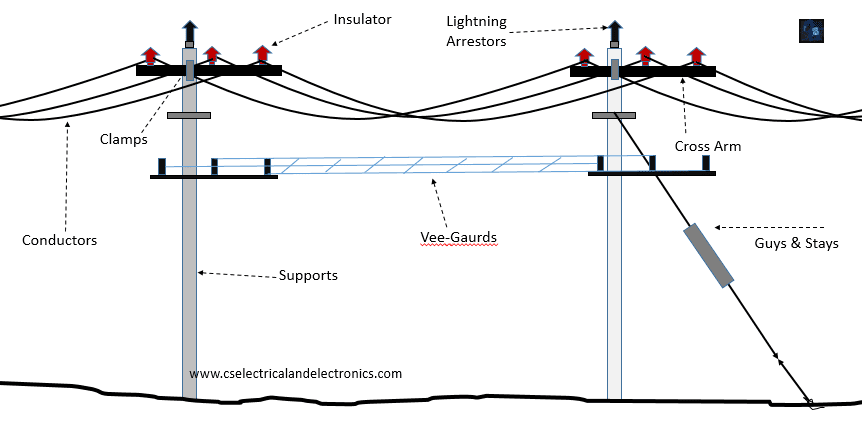Overhead Line Components, Functions Of Components In Overhead Lines
Hello guys, welcome back to our blog. In this article, we will discuss overhead line components, functions of components in overhead lines, the type of materials used for the conductors, types of insulators used in overhead lines, etc.
If you have any doubts related to electrical, electronics, and computer science, then ask questions. You can also catch us on Instagram – CS Electrical & Electronics.
Also, read:
- Top Best MTech Branches For Electrical & Electronics Engineers
- Top 100+ Electrical & Electronics Quiz Questions With Explanation
- Top 10 Different Power Plants In India, Solar, Thermal, Wind, Hydro
Overhead Line Components
The power generated in the generating station is transmitted to the distribution centre using the Overhead lines. As we know the power system is mainly divided into three divisions as Generation, Transmission, and Distribution. Generation is totally dependent on the power station’s electrical energy generation. Transmission is the link between the generating station and the distribution centre. In transmission, overhead lines are the main equipment used to transmit electrical energy.
In the process of transmission, the Overhead lines and Underground are the two main ways used to transmit electricity. The overhead lines are the major applications used in the transmission compared to the underground lines. Overhead lines are easy to maintain compared to underground cables. According to the comparison of factors mostly used are overhead lines for transmission.
Overhead line transmission consists of different components to transmit the power. The major components used for the Overhead line transmission are:

01. ACSR Conductors
The lines used for the transmission and distribution of electricity are called conductors. The conductor is mainly used to carry the electrical energy from the generating station to the distribution substation and from the distribution centre to the consumer load centres. Conductors are the most expensive component in the overhead line transmission as the different parameters are taken into consideration for the material selection of the conductor. The size, shape and type of material used are the main factors in selecting conductors.
During the material selection, the current rating and the span of current-carrying factors will play a key role such as they will decide the type of composition that should be used for the conductors. The type of materials used for the conductors are:
a. Copper: The main factor of using copper is that it holds the highest conductivity factor. The most commonly used material for conductors is copper. There are mainly three kinds of copper such as soft-drawn, medium-drawn and Hard-drawn. The hard-drawn copper is used for the construction of the conductors. The main factors for selecting hard-drawn copper as it has less elastic factor and more mechanical strength which will make the conductor withstand high currents. Due to expensive factors, copper is not directly used for overhead transmission.
b. Aluminium: the most commonly used conductors are made up of aluminium as it is less costly. The weight is also lighter compared to the copper, this advantage makes the pole strength factor decrease. ACSR and AAAC conductors are mainly used for the transmission lines. ACSR is made up of small strands of aluminium twisted together used for the conductors. The twisting of the aluminium strands will give more tensile strength which is used to withstand heavy currents. The main disadvantage of aluminium is it has less conductivity compared to copper and less tensile strength.
c. Galvanized Steel: the major advantage of Galvanized steel is it is cost-effective. It is used for short-distance power transmissions as it consists of some drawbacks such as low conductivity, high resistance and less tensile strength.
d. Cadmium Copper and Copper weld steel are rarely used because of their most expensive factor.
02. Insulators
The material which holds the property of Insulation is called an Insulator. Insulation means property to oppose the flow of current which is the exact opposite to the conductor. The major application of using the insulators is to provide the support for conductor and maintain distance from one conductor to the other.
Usage of the insulator will decrease the leakage currents and avoid short-circuiting between the metal supports and the conductors. Porcelain, Ceramic, Glass and stealite are mostly used as insulating materials for the design of insulators. There are mainly five types of insulators used in overhead lines,
Types of insulators used in overhead lines
a. Pin-type insulators: These insulators is mainly used up to 33KV.
b. Suspension Type Insulators: These insulators are high insulating capacity holders which are used up to 11KV to 765KV operating voltages.
c. Strain type Insulators: The strain type insulators are used up to 220 KV operating voltage. Strain insulators are made as a group of disc insulators. The rating increases the rings in the insulator and also increases vice-versa.
d. Stay Type insulators: Stay type insulators are mainly used for low voltage purposes.
03. Supports
Supports are used to support the Conductors which are called poles or towers. These supports will hold the conductor from a specific height from the ground according to the operating voltage. Poles are mainly divided into four types,
- Wooden pole
- Steel pole
- RCC steel towers
- Lattice steel towers
04. Cross-Arms & Clamps
Cross-arms and clamps are used mainly for supporting and holding the Conductors and insulators. Cross arms are of various types which are used to hold the conductors in different angles such as Line cross-arms, power cross-arms etc. The cross-arms are mainly made up of wood or steel.
05. Guys & Stays
The Guys and Stays are used for the termination of the lateral forces by making the pole support in angle.
06. Lightning Arrestors
Lightning arrestors are used for the protection of the overhead lines from high voltage surges. The lightning arrestors are placed at the top of the overhead line as it collects the high voltage surges and give them to the ground. Lightning arrestors play a vital role in bad weather conditions mainly during rainy climates.
07. Fuses & Isolating Switches
The fuses are used to protect the appliances from high voltages and faults. The isolating switches are used for isolating the different appliances in transmission.
08. Earth Wire
Earth wire is used for collecting high voltage from lightning arrestors and supplying it to the earth. The earth wire will be running on the top of the tower.
09. Vee-Guards
These guards are used for public safety, these are provided below the overhead line along the transmission lines.
10. Gaurd Wires
These guard wires are used while crossing communication lines. They may be placed above or below the overhead lines and connected to the earth solidly.
This was about ” Overhead Line Components “. I hope this article ” Overhead Line Components ” may help you all a lot. Thank you for reading.
Also, read:
- 10 Tips To Maintain Battery For Long Life, Battery Maintainance
- 10 Tips To Save Electricity Bills, Save Money By Saving Electricity
- 100 (AI) Artificial Intelligence Applications In The Automotive Industry
- 100 + Electrical Engineering Projects For Students, Engineers
- 1000+ Control System Quiz, Top MCQ On Control System
- 1000+ Electrical Machines Quiz, Top MCQs On Electrical Machines
- 1000+ MATLAB Simulink Projects For MTech, Engineering Students
- 50 Tips To Save Electricity At Home, Shop, Industry, Office
Author Profile
- Content Writer
Latest entries
 All PostsNovember 29, 2021Overhead Line Components, Functions Of Components In Overhead Lines
All PostsNovember 29, 2021Overhead Line Components, Functions Of Components In Overhead Lines All PostsSeptember 26, 2021Types Of Devices Used To Improve Power Factor, Power Factor Correction
All PostsSeptember 26, 2021Types Of Devices Used To Improve Power Factor, Power Factor Correction All PostsJune 20, 2021Top 10 Universities For MS In The World, MS Universities In The World
All PostsJune 20, 2021Top 10 Universities For MS In The World, MS Universities In The World All PostsJune 20, 2021Top 10 Universities For MTech In The World, MTech Universities In World
All PostsJune 20, 2021Top 10 Universities For MTech In The World, MTech Universities In World








